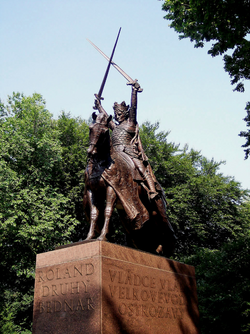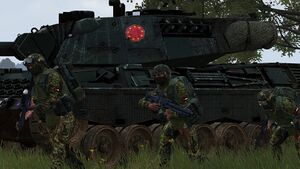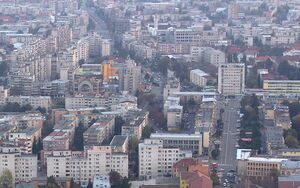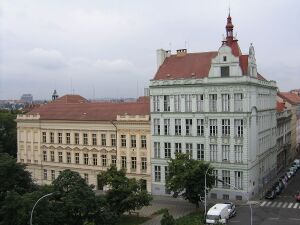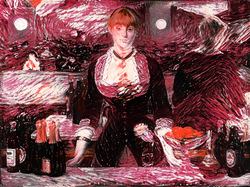Ostrozava
This article is incomplete because it is pending further input from participants, or it is a work-in-progress by one author. Please comment on this article's talk page to share your input, comments and questions. Note: To contribute to this article, you may need to seek help from the author(s) of this page. |
Prime Republic of Ostrozava | |
|---|---|
| Motto: "Vultus in Ainata." "Glory in solidarity." | |
| Anthem: "Probuď své bolavé srdce, Ostrozavane!" "Awaken your aching heart, Ostrozavan!" | |
 Ostrozava's Location in Belisaria | |
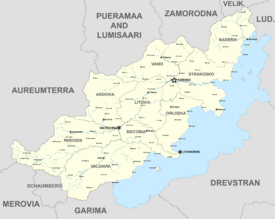 Political Map of Ostrozava | |
| Capital | Karsko |
| Largest city | Valegoria |
| Official languages | Common Ostrozavan |
| Recognised regional languages | Ardovian, Diodelian, Livalian, Baderian, Magnish, Virinian |
| Ethnic groups (2020) | |
| Religion |
|
| Demonym(s) | Ostrozavan |
| Government | Federal socialist two-party premier-presidential constitutional republic |
• Primar | Benedict Král |
• Facilitatorá | Nela Repkov |
• Supreme Justice | Alan Michálek |
| Legislature | People's Congress |
| Area | |
• Total | 256,160 km2 (98,900 sq mi) |
| Population | |
• Estimate | 77,204,940 |
• Census | 2009 |
| GDP (nominal) | 2018 estimate |
• Total | 1,076,896,988,300 |
• Per capita | 28,945.98 |
| Gini (2018) | 36.9 medium |
| HDI (2018) | 0.729 high |
| Currency | Lev (ꬸ) (OZꬸ) |
| Time zone | Belisarian Central Time (+1) |
| Date format | DD/MM/YYYY |
| Driving side | right |
| Calling code | +450 |
| Internet TLD | .oz |
Ostrozava, officially the Prime Republic of Ostrozava (Ostrozavan: Primarní Republika Ostrozavskă), is a country in central Belisaria. It is bordered to its north by Cynereth and Suvarova, to the west by Hvalheim, to the southwest by Vannois, to the east by Drevstran through the island of Deryzlde, and to the south by Garima through the former nation of Polnitsa and the regions of Milcenia and Tungria. It also shares maritime borders with Suvarova, Drevstran and Garima. The Prime Republic has a landlocked and hilly landscape that covers an area of 256,160 square kilometers (98,904 sq mi). Consisting of the majority of the region of Transkarminia, Ostrozava hosts a temperate and hilly climate dotted by the Ardullian and Tyvarian mountain ranges arising on its borders with Garima and Cynereth respectively. A large part of the nation borders Lake Kupalnitsa, giving it several hundred kilometers of beaches. It is a federal presidential republic that has operated in a spiritual-scientific consensus known as the Third Compact since 1957. with 77.2 million inhabitants. Its capital and largest city is Karsko, with 2.1 million residents; other major cities are Valegoria, Levigorsk, Táborov, and Libebor.
Ostrozava is a developed country with an advanced, high income social market economy. Ostrozava is often considered to operate in the political paragdim between a socialist state and a traditional presidential democracy. It is a federal republic and a representative democracy anchored in worker's rights and left-wing ideology, although it does not consider itself a socialist state officially; one of the two major politically active parties in Ostrozava is the Socialist Party. Economically, Ostrozava is a welfare state with a Socialist model, universal health care, and tuition-free university education. It ranks as the ninth safest and most peaceful country, though it performs lukewarmly in democratic governance due to alleged existence of a powerful deep state.
The territory of modern Ostrozava was inhabited by the Proto-Gothic people from the 2nd millennium BCE onwards, an distribution which culminated in Tervingia. Following several migrations of Eastern Latinic and Slavic peoples, several new states formed after Tervingia's collapse, including the Latinic Kingdom of Livalia and the Slavic Duchies of Karsko, Baderia and Vamo. From the 9th century onward, it was further occupied by migratory Germanic peoples, the latter putting the region in the periphery of the nascent Holy Aulian Empire. The Grand Duchy of Ostrozava formed in 1142, and the Alban-majority state engaged in several expansionist wars, adding Polnitsa and Tungria to its territory. After the arrival of Fabrianism and Doceticism, the region became marred by intermittent religious wars for several centuries, with periods of peace often coming through control of the Lake Kupalnitsa trade area or alliance with the Lushyodorstag. The Ostrozavan Declension led to the seccession of substantial parts of the regions of Livalia and Rheigen, and the entirety of Polnitsa. United by marriage and Alban faith, the state of Livalia-Rheigen served as a fulcrum against the reigning Fabrian Váskory and later Belododia dynasties. The Protestant reformation greatly influenced the ideas of many throughout Transkarminia, including those of Nazarist persuasion; by 1729, a coalescing of several Nazaro-Protestant nobles and cultural forces led to the establishment of the now-infamous Vykopal dynasty. Influenced by all major denominations of Belisarian Sarpeticism in the region, Karminian Christianity anchored the Vykopal dynasty's power.
Following some decades of growing movements, the First Worker's Convention overthrew the Grand Duchy in the 1909 Crimson Revolution and established the current Prime Republic of Ostrozava. As a fragile newcomer to the Belisarian political stage, in 1921 Ostrozava attempted to strengthen its political system in order to appease more traditionally Wernerist elements arising in the nation in response to the Drevstranese Civil War and the Rytieriroz. The subsequent Second Worker's Convention which established the two-party paradigm known as the Second Compact. Known for a careful and often clandestine foreign policy stance, the Prime Republic went through several more reforms through its history, including the formation of the Third Compact in 1957 following the public unrest around the Hauland War, the abolishment and subsequent re-legalization of religious education, and the declaration of neutrality in 1990. In the 2020 election, the Union of Liberated Socialists won both the Primarship and People's Congress, after almost thirty years of government control by the Union of Progressives and Technocrats. Ostrozava recently rescinded its "hard" stance on neutrality, and resumed operating under rules enshrined in the original Social Contract. Ostrozava is a member of the Angrast Accord, Kiso Pact and Forum of Nations, and is the headquarters of the ITU through the latter.
Culturally, Ostrozava is considered part of both central and eastern Belisaria, situated within the confluence of the Ardullian and Tyvarian Ranges, in the historically strategic region of Transkarminia. Ostrozava is populated by several ethnic groups, with over and substantial minorities of Tervingian Goths, and Ludz, as well as many immigrants from an international diaspora centered on Ottonia, Tsurushima and Jhengtsang. The official language of the country is Common Ostrozavan, a standardized variety of the Karsko dialect of Ostro-Ludzic, with influence from Magnish and Livalian contributing to the Ostro-Ludzic dialect continum in various major ethnolinguistic areas, including The most distinct variety of Ostro-Ludzic within Ostrozava is Simerian, which is spoken on the coastline of Livalia and holds closer similarities to Polnitsan. Magnish is a recognized regional language in the S.R. Ardovia and S.W.R Rheigen, and Livalian is a recognized regional language in S.R. Livalia.
History
Early history
Humans have inhabited the Transkarminian basin for millenia. Ostrozava's prehistory is predominantly marked by a variety of small Germanic polities in the basin, which eventually coalesced around the Western Gothic City-Kingdom of Saragetra (modern Valegoria), which in turn became the nexus of the collosal Tervingian High Kingdom and the site of its proclamation in approximately 323 BCE. The Tervingians often warred with the Gaets, as well as the Kingdom of Hétumoger under Janos I, and the outermost reaches of the Latin Empire, which at one point reached modern Livalia.
Starting in 428 CE, the second migration of eastern peoples arrived in an increasingly-bloated Tervingian system; this time, the Slavs had arrived, and began to alternatively integrate into, trade with, or raid the rapidly-fracturing empire. With the arrival of new peoples from all directions also came the arrival of several new religions, chief among them the Nazarist Albans, which often combined with, and superceded, local pagan religions through a liberal use of syncreticism. The Transkarminian basin was one such point of convergence for both Albanism and Slavic migratory tribes, along with the eastern coast of Lake Kupalnitsa, in modern day Drevstran. The Kingdom of Karsko, formed around the self-named new settlement of Slavs north of the repeatedly-pillaged Saragetra, soon established itself as the predominant force in the basin, as both a military power using innovative tactics of the Slavic peoples, as well as a prolestryzing Alban religious power, which often gave smaller polities ultimatums between inclusion under conversion, or eradication. Several new dialects emerged in the region, primarily the Proto-Ostroludzian dialect of the Kingdom of Karsko and the Proto-Livalian language, formed from a combination of Latin, Slavic, and Germanic influences.
Politically, Livalia, then a nascent kingdom coming out of the collapse of Tervingia, also converted to Albanism, and established itself as a dominant trading power in the south of the lake, trading with the newly-arrived Lushyodorstag as well as Morinia. By 600 CE, the Transkarminian region had stabilized into the Kingdoms of Karsko and Livalia, as well as several smaller city-states, duchies, and other polities, among them the important cosmopolitan harbor of Levigorsk and the Saxo-Gothic Duchy of Rheigen.
Medieval Period
Throughout the 9th century, the Kingdom of Karsko, under the Ludzic Bednář family, expanded into greater northern Transkarminia, invading and incorporating the Duchies of Vamo and Baderia. A complex political situation and religious pressure, however, had the final king of Karsko, Libor Bednář ousted by a conglomerate of chiefly Alban Tervingo-Slavic chieftains. The most powerful of these chieftains, Roland Válek, soon rose to power to become the first Grand Duke of Ostrozava, retitling himself as Roland I after formally creating the title of Grand Duke to consolidate his power over the formerly independent petty states of the North. He died in 1176 of what tradition alleges was a stroke in a brothel. His third-born and oldest surviving son, Otmar the Builder (Ostrozavan: Otmar Stavitel) succeeded him.
Otmar the Builder, widely considered to be one of Ostrozava's most effective and even legendary rulers, died after a period of prolonged peace in 1237, having gained the respect of both the political establishment and the religious establishment, while establishing trade routes to eastern states in Morinia, Azdraï and the Lushyodorstag. Otmar had also presided through a period of rising tensions with the southern Kingdom of Livalia, after claiming the Kingdom via historial precedent in the marriage of the Tervingian ruler Alica to the eldest daughter, Raluca, of the confederation of Valenian chieftains, a precursor of the Kingdom of Livalia, in 327 BCE. The Duchies of Rheigen and Tungria, in the west, came under the influence of the Holy Aulic Empire.
The powerful Válek dynasty would go on to continue the Karskian legacy of territorial consolidation in Transkarminia in the Ostrozavan Wars of Expansion; from Zikmund Válek's 1242 expansion into Livalia onward, the Grand Duchy of Ostrozava would go on to take Polnitsa, Rheigen, Milcenia, and Tungria from the Holy Aulian Empire by 1309. A Fabrian uprising in southern Ostrozava halted further expansion into Imperial lands by 1311, leading the Váleks to set their sights on the greater Alban world in an attempt to unify the Kupalnitsa area against future Fabrian expansion. The Ostrozavan Invasion of the Lushyodorstag, despite initial victories, failed after the Ostrozavan defeat at the Second Battle of Barbellon, which also led to the death of the primary Válek heir, Prince Gabriel, in 1320.
Gabriel's death and the failed invasion had drastic internal consequences for Ostrozava. Kamil Válek, Count of Karschberg and third-in-line to the throne, challenged the new Grand Duke Viktor's claim, leading to the disastrous First Ostrozavan War of Succession, which lasted from 1329 to 1335, with a win for the dominant branch of the Válek family and a consolidation of power under Viktor I.
Eastern Renaissance
Ostrozava's central position in Belisaria made it a crossroads for the wider region, recieving trade from both east and west of Lake Kupalnitsa; religious tensions with the Fabrian world remained high, as did those with Hvalheim. In 1405, the Council of Pyrovegny was held in the Lushyodorstag, bringing a degree of denomenational unity between the Docetic and Alban Nazarist lauras in the face of encroaching Fabrian dominion over the continent. The Council's primary achievement was consensus on the contents of the first Oecumenical Bible, which would be valid for both Albans and Docetics. The advent of the Council opened up exchange and communion between communities of the two denominations; the Docetic Church's first missionaries arrived in Livalia in 1407, garnering protest from remaining Fabrian nobles and general indifference or even tolerance from the Emendatic priesthood and political establishment.
Declension and Tungrian War
XXXXXXXXX
XXXXXXXXX
XXXXXXXXX
XXXXXXXXX
Vykopal Era
In 1694, with the Triple Crown across the lake gaining considerable power, the Belododia family began to lose remained of its declining power to the Kostra and Vykopal dynasties; the Vykopals, under Dukes Tudor and Letisov, had been gaining power throughout the rule of the Belododia dynasty since the end of the Declension, while the powerful and old Kostra dynasty had long been vying for political influence within Ardovia and the Valek era beforehand. Wary of another war of succession, Aurel III Belododia, in ailing health, formally designated Duke Vavrinec Vykopal of Levigorsk as his official successor in lieu of his obese son, Bohus Belododia, which came as an unprecedented shock in post-Declension political culture. As a result, Duke Baltozor Kostra raised his flag in rebellion against the Belododia dynasty, intending to install Bohus as a puppet; the Vykopal professional standing army smashed the Kostra's levy-based host, virtually handing over total power to the Vykopal dynasty.
Upon Aurel III's death in 1729, Vavrinec Vykopal formally became Grand Duke of Ostrozava, and, despite having been a devout Emendatic Christian himself, decreed that all denominations went against the will of the Grand Duke. Successively through the 1730s, Vavrinec first endorsed Lutheranism, and later the "Alban-Lutheran pact", a phenomenon which soon developed into the state-sponsored Karminian hybrid faith. While the new state church was ostensibly still Protestant, it nevertheless incorporated huge swathes of Docetic and Alban doctrine, including strict nontrinitarianism. The new faith was enforced strictly by Grand Duke Vavrinec, who forced en-masse conversions of the majority of the nation to the faith throughout the 1740s, attracting the ire of both the Alban and Fabrian worlds, including Pope Florentine.
After Vavrinec's death from gout in 1768, his only child, Aliana Vykopal, became the first and only Grand Duchess of Ostrozava; with the longest reign of any Vykopal, Aliana is noted for her exotic lifestyle, hot temper, and political marriage to Jovinus Claudius of the Latin Empire, which normalized relations with the West. Later in life, Aliana would go on to establish a highly centralized and modern nation, especially for the region, ruling strictly while using Karminian doctrine as an organ of state control. At the end of the 18th century, Garima and Latium served as important allies for Ostrozava in lieu of its earlier alliances in the Kupalnitsa area. Vykopal-era Ostrozava is sometimes considered to have constituted the easternmost member of the Western Monarchies.
Grand Duchess Aliana's health began to fail in the 1820s but she nevertheless presided over several controversial accomplishments, including the levying of unpopular taxes to modernize the nations' industrial capacity. The first factories, specializing in textiles and early forays into canning, opened in 1821 and 1823, respectively, in the Valegoria area, which soon became a nexus of the Industrial Revolution.
Growing Unrest and Rifler's Strike
Feudal authority suffered a serious setback in 1824, when Aliana Vykopal, having enacted several unpopular tax policies, died to an assassin's bullet; the apprehended assassin, Marek Čiernik, had been radicalized into action by witnessing successful resistance to unrest in Merovia. Marek Čiernik was a prominent intellectual in the Lake Kupalnitsa area, having been credited with the first functional lightning rod in the nation in 1811; his arrest and subsequent execution greatly impacted the growing clade of Ostrozavan academics. Ostrozava's rapid modernization, which included an at-least cursory education for the majority of the nation, exposed many to the ideas of Werner and Alençon.
Though Čiernik's ploy to start a revolution failed, with Aliana's young son Aurel IV cracking down on what remained of personal freedoms in Ostrozava as a result, the assassination is widely regarded as the first impactful antimonarchical action in Ostrozava since Baudry Zyler. The assassination served as the crucible of what would become a century of oscillation between unrest and crackdown. Aurel IV died in 1855, leaving the nation to his son, the controversial and often-ineffective Peter II. Peter II greatly centralized noble rule, almost eliminating mobility within the clade, including the granting of titles, while centralizing almost all power away from former feudal lords and into the Grand Duke, a move that would prove unpopular even among the inner council. The monarchy continued to emphasize Karminian doctrine, attracting the long-term ire of Alban and Docetic movements and nations, including the Drevstranese Triple Crown.
In 1884, several important Ostrozavan armaments factories to a standstill in the famous Rifler's Strike, which crippled Peter II's military modernization program. The armaments workers defended the factory from police and early military incursion until the foreign-armed Royal Guard forcefully reopened them in early 1885 at The Rifler's Battle. The government's forceful response to growing anti-Vykopal sentiment, particularly the Rifler's Strike, drew naysayers out from even the rank-and-file military, leading to a decline of anti-populist decrees by Peter II for the remainder of his reign.
After Peter II's death in 1891, his son Borek I took power over an increasingly antimonarchical sentiment within the nation; as a young ruler at his ascension in 1891, he often found himself at odds with both older members of the nobility, which had grown increasingly dissatisfied with the strict rule and Karminianism of the Vykopals, as well as the growing Karsko University Drinking Club, which included prominent academics and philosophers such as the mystic philosopher Vlastimil Beran, anti-monarchist Julius Jahoda, pseudo-Wernerist critic Vladan Vítek, psychoanalyst Stan Bača, and feminist Loren Kralová.
In 1901, having taken note of the rise of international revolutionary liberal and leftist movements throughout Belisaria and beyond in the past century, the Karsko University Drinking Club published the Crimson Manifest. The Manifest outlined the demands of the Drinking Club in response to the increasingly unpopular reign of the Vykopals, including the abolition of serfdom, Karminianism, a 70-hour work-week for factory workers, and more. Chiefly penned by burdgeoning socialist Vladan Vítek, the Manifest became a rallying cry for the peasantry and workers in the partially-industrialized nation, reinvigorating the popular movements initially catalyzed by the Rifler's Strike. Rioting and strikes of minor industries intensified over the next half-decade; in 1905 the Grand Duchy of Ostrozava formally abolished serfdom, being one of the last states in Belisaria to commit to the policy. The abolition of serfdom sent hundreds of former serfs flooding into the cities, creating a homelessness crisis amid the winter of 1905-06, which saw over 2,500 dead of hypothermia. The Black Winter of 1906, named for the frostbitten former serfs' blackened features, would see blame laid at the feet of the Vykopal dynasty.
Crimson Revolution
In response to the increasingly bleak situation brought about by the Grand Duke's mishandling of the Black Winter and abolition of serfdom, prominent intellectuals in Ostrozava, including the Drinking Club and other anti-establishment thinkers, coalesced at the 1st Ostrozavan Worker's Convention of 1907. The Convention did not initially advocate for armed revolution, but instead took the route of compromise in aiming for a constitutional monarchy with greatly increased worker's rights. Internally, the convention had seen a rift develop between the Worker's Party and League for Democratic Reform, primarily over theoretical and ideological differences as to the role of the market. In mid-1908, after the Convention published several proclamations doubling down on the Drinking Club's original Manifest, Borek Vykopal made a public speech denouncing the Convention as enemies of the state. Borek's proclamation soon ended internal squabbles in the Convention, particularly between heads of the LDR, Julius Jahoda, and Worker's Party, the young Emil Torje, as the situation's urgency required unification. Before the end of the year, internal compromise had been reached, and the monolithic United Republican Party had been created, in an effort to directly oppose the Vykopals.
On 21 March 1909, the Worker's Convention submitted their demands to the Grand Duke, including the first draft of the Ostrozavan Social Contract as written by Vladan Vítek, long considered the head of the Convention's faction for compromise and most skilled author. Grand Duke Borek denied the Worker's Convention's demands, and, gambling for the military's loyalty, ordered the arrest and execution of the Worker's Convention leadership. The orders shook the Ostrozavan military, which had already faltered in its tantamount support of the Vykopal dynasty after the Rifler's Strike. In response, the military denied the Grand Duke's order as "immoral and un-Dukelike", but did not offer support to the Convention, either. The summer of 1909 brought mass rioting and civil unrest throughout the Grand Duchy; several noble families, particularly those of Livalia and Rheigen, began to flee into neighboring Garima and Vannois, escalating the situation and the military's to-be role in it. In October 1909, after the Grand Duke ordered the execution of military leadership for treason, the military formally declared its tentative allegience to the Worker's Convention, and on 14 November 1909, the Grand Duke was formally deposed and executed in a trial by combat by crowds in Karsko in support of the First Convention; the rest of the Vykopal family disappeared and were presumed dead trying to cross the border into Cynereth. The remaining Ostrozavan noble families fled to Drevstran, or else renounced their noble status by early 1910. The events of 1909 as a whole are now considered to constitute Crimson Revolution.
First Compact
On 1 July 1910, the first draft of the Ostrozavan Social Contract was ratified and the Prime Republic of Ostrozava formally created, with Julius Jahoda being elected as the first Primar as part of a united coalition. By 1912, the compromise between the Convention's factions had faltered, and the Socialist Worker's Party split from the United Republican Party, with the latter holding on to urban and educated support while the latter surged in the countryside with former serfs and peasants, as well as some workers. Within a year, other political complications plagued the young republic, including diplomatic hostility from the Gariman crown, as Queen Albina of Garima was the last surviving Vykopal, the developing Drevstranese Civil War, and the rise of the ultranationalist pan-Alban Rytieriroz.
In 1916, amid questions as to the level of potential Ostrozavan involvement in the Drevstranese Civil War on the side of the Farkas Band, compromise candidate and Contractual author Vladan Vítek became Primar. Though himself a socialist, he realized the importance of compromise from his time orchestrating the Revolutionary Compromise, and earlier from his time in the Drinking Club; as such, Vítek ran what is considered to be a centrist administration, which coincided with the rise of the Rytieri. Lack of formal or strenuous government response to the Rytieri had reactionarily galvanized the Socialist Worker's Party; by 1919, the Socialists led the nation in most registered members, eclipsing the United Republican Party. The Socialists, still led by Emil Torje, saw the Rytieri as a national threat and advocated for the "systemic dis-emphasis of religion" as a result; the Socialist position drew popular support from many who had been disappointed or raised under Karminianism, but also sent devout Fabrians and Albans flocking to the United Republican platform.
After several Rytieri marches in 1920, a concentrated labor movement began under the SWR's umbrella, seeking even better working conditions, including a two-day weekend, as well as a government crackdown on the Rytieri. Throughout 1921, despite interference from the Ostrozavan Prime Army, several skirmishes unfolded between the Rytieri and Socialist Worker's Party in especially Alban areas of Ostrozava; this time period of 1920-22 came to be known as the Bat Summers from the militia's choice of weapon.
Second Compact
In 1922, the People's Congress and Primar Vítek called a Second Worker's Convention in an effort to resolve increasingly stark political divisions over the situation on the ground; the result was the enshrining of Wernerist thought, strong union and labor protections, and the concept of permanent revolution directly into the Ostrozavan Social Contract. Following the official adoption of the new provisions, Vítek announced his intention to step down in 1923, leading to a snap election from which Emil Torje of the Socialist Worker's Party emerged victorious with 52% of the vote.

Torje's rule would mark the beginning of the Second Party Compact, in which the Socialist Worker's Party would hold constant majority. Major economic reforms from 1924 onward resulted in the implementation of a hardline internationalist communism; throughout the nation, many major industries, including that of food production, were fully nationalized and placed under a quota system and command economy. Rytieri-adjacent members of society were marked as dissidents and jailed or executed. Internationally, the Prime Republic began looking for allies; between 1925 and 1930, the Prime Republic signed treaties with socialist Walzenia and _____ and showed open soldiarity for the burdgeoning North Ottonian socialist movement during the Ottonian Civil War. In Transkarminia, relations with Garima and Hvalheim became especially cold, while, due to pragmatic politics, relations with the Orbraggarist Drevstran remained cool but cordial.
Primar Torje died suddenly in an auto accident in Levigorsk on 27 March 1930 in a move that is retroactively believed to have been orchestrated by his immediate successor, first PRCO director and Subprimar Alek Dalibor, who would go on to blame Torje's death on Invictist activity from Suvarova, which he accused of funding the Rytieriroz in the previous decade. This act consolidated Dalibor's domestic power behind an atmosphere of fear far more intense than that of Torje's administration, but also caused diplomatic troubles.
Internationally, Dalibor would commit Ostrozavan troops to the Great Ottonian War in 1937, formally embroliling the Prime Republic in its first ever ideological conflict. Further help would be given to the young Jhengtsang's invasion of Norok via the establishment of the Ostrozavan Foreign Legion in 1946. Ostrozavan forces would continue to fight in conflicts worldwide in support of socialist movements until the end of the Great Ottonian War in 1943 caused a domestic economic crisis that coincided with the Typhoid epidemic of 1944.
Second Partisans' War and Chaos of '57
New Society and Progressive Era

XXXXXXXXX
XXXXXXXXX
XXXXXXXXX
XXXXXXXXX
Modern History
XXXXXXXXX
XXXXXXXXX
XXXXXXXXX
XXXXXXXXX
Geography
The Ostrozavan landscape is varied. Rheigen, to the west, is host to the Tyvarian mountains, a low mountain range on the border with Cynereth; the Ardullian mountains, on the other hand, constitute the border with Garima and are considerably higher through their tectonic formation through the pressures of the Karminian and Belisarian plates. Ostrozava's highest peak is Oglav, at 3,574 m (11,725 ft). Litonía, in the central part of the country, is also quite hilly. Ostrozava has two main waterways, both flowing eastward into Lake Kupalnitsa. The first and largest river is the Karmin river, which flows through Karsko. The nation's second largest waterway, the southeastern-flowing Balrog River, merges into the Karmin in at the Great Fork, currently the focal point of the city of Valegoria.
Phytogeographically, the vast majority of Ostrozava is located inside the Central Belisarian Plain. According to the IBEST Conservational Fund, the territory of the Prime Republic can be subdivided into four ecoregions: the Central Belisarian broadleaf forests, Karminian grove forests, Tervingian mixed forests, and Ardullian montane conifer forests.
Ostrozava has one of the largest areas of undisturbed forest in Belisaria, covering almost 30% of the territory; recent lumber drives have significantly cut back this number. Some 4,200 plant species have been identified in the country, from which to date 15 have been declared natural monuments, 26 missing, 123 endangered, 340 vulnerable, and 2,150 rare.
Temperate forest in northern Litovia.
Government and politics
The Prime Republic is a unique form of federation, officially describing itself as a "People's Federation", or "Worker's Federation" (Ostrozavan: Dělnická federace). It is a representative democracy, "in which majority rule is tempered by minority rights protected by law". The government is regulated by a system of checks and balances defined by the Ostrozavan Social Contract, which serves as the country's supreme legal document and constitution. For 2018, the P.R.O. ranked 39th on the Democracy Index and 12th on the Corruption Index. In the Ostrozavan socialist-federalist system, citizens are all unilaterally subject to three levels of government: Prime, Subprime, and Local. The local government's duties are typically split between city governments and county governments, with the former holding jurisdiction over urban areas while the latter hold jurisdiction over rural and suburban areas. In almost all cases, executive and legislative officials are elected by a plurality vote of citizens by district; representation at all levels is typically first-past-the-post in nature, though some areas have local variation or proportional representation.
The Prime government comprises three branches:
Legislative: The unicameral People's Congress, headed by the Facilitator, makes federal law, declares war, approves treaties, has the power of the purse, and has the power of impeachment, by which it can remove sitting members of the government. It also has the ability to amend and change the Social Contract. The Primar selects the Facilitator, but only the People's Congress may approve the selection. The Minister of Finance is selected by the Facilitator; if the dominant party in the People's Congress is not the Facilitator's, the Facilitator may issue a two-week delay on any bill passed by the ruling party, after which it shall be sent to the executive, unless it is of a financial matter, in which case it will pass automatically. Since 1970, this state of affairs is commonly called an Unfacilitatorship.
Executive: The Primar acts as the head of state, chief diplomat, and head of Foreign Affairs. As Ostrozava is a semi-presidential system, the Primar names but cannot dismiss the Facilitator. The Primar also holds the power of dismissing the People's Congress, calling a Worker's Convention, naming but not approving various executive officials, and exercise a one-time suspensive veto of six months. The Primar also has control over internal executive matters, administering and enforceing Prime laws and policies; all of the Primar and Facilitator's decisions are subject to Congressional override.
Judicial: The Supreme Court and lower Prime courts, whose judges are appointed by the People's Congress, interpret laws and overturn those they find unconstitutional; they are considered to have the final say on all matters relating to the Social Contract. They collectively hold jurisdiction over the Ostrozavan Defense Force, though the Prime Commander is self-selected.
The People's Congress has 350 voting members, each representing a congressional district for a two-year term. Congressional seats are apportioned among the subprime voting districts by population every twenty years. The Subprime governments are structured in a roughly similar fashion as the Prime, though the Social Contract allows them leeway in organization. The executive of each state is directly elected, with most consisting of committees instead of individual positions. Most state judges and cabinet officers are appointed by the governors of the respective states, while others are elected by popular vote; many municipal governments, especially those traditionally belonging to the Socialist Party, have organized themselves as Worker Collectives or organized unions.
Law
Ostrozava is a federation with a civil law system based on the continental type, rooted in Bauerist and Tsurushiman legal culture; Ostrozavan law is considered a distinct subset of Belisarian law. The basis of the legal system is the 1985 Legal Amendment to the Ostrozavan Social Contract. The court system includes municipal, subprime and prime courts and is divided into civil, criminal, and administrative branches. The Supreme Court consists of 15 constitutional judges and oversees violations of the Constitution by either the legislature or by the government. It also has jurisdiction over many political matters, such as the formation and closure of political parties, jurisdictional boundaries between government entities, and the eligibility of persons to stand for public office. As the Supreme Court has full jurisdiction over constitutional interpretation, and as such they are considered to have jurisdiction over the Ostrozavan military, which is itself semi-autonomous.
Federal subjects
Internally, the Ostrozavan state is divided into nine constituent republics, established in 1928, and three autonomous areas consisting of the federal capital of Karsko and the megacities of Valegoria and Levigorsk. In descending geographical order, these subprime constituencies are:
| Name | Capital | Flag | Coat of Arms | Location |
|---|---|---|---|---|
| Karsko Autonomous Urban Zone | Karsko | |||
| Valegoria Autonomous Urban Zone | Valegoria | |||
| Levigorsk Autonomous Urban Zone | Levigorsk | |||
| Subprime Socialist Federation of Baderia | Buděrec | |||
| Subprime Socialist Collective of Strakosko | Kostromo | |||
| Subprime Republic of Vamo | Táborov | |||
| Subprime Republic of Litovía | Libebor | |||
| Subprime Republic of Orloşka | Orlorec | |||
| Subprime Republic of Ardovia | Hodonov | |||
| Subprime Commonwealth of Siecobia | Brastra | |||
| Subprime Republic of Livalia | Balta | |||
| Subprime Worker's Republic of Rheigen | Helbarstätt |
Foreign relations
Traditionally, Ostrozava has avoided formal alliances that might entail military, political, or direct economic action; the Ostrozavan Social Contract outlines a general policy of non-interventionism, though the nation has bent this rule many times in the past. Under Primara Eva Sedláková, Ostrozava formally adopted a policy of neutrality in 1989, further bolstering its non-interventionist rhetoric. Only in 1990 did Ostrozava become a full member of the Forum of Nations; it was the first state to join it by referendum. In 1995, Karsko became the headquarters of the newly-created Intercontinental Telecommunications Union, a then-controversial move, given the recency of Ostrozava's admission to the organization.
Owing to its ideologically mixed base, Ostrozava has maintained solid diplomatic relations with a variety of ideologically diverse nations since its reconstitution. A primary ally of Ostrozava since its reconstitution has been North Ottonia. Ostrozava also maintains warm relations with Vardana and Valgtea. Though tentatively indifferent towards each other, Ostrozava has enjoyed positive trade relations with Jhengtsang and Tsurushima; Ostrozava has special trade partnerships with Tsurushima and North Ottonia. Though not formally entangled in opposition to the Western Monarchies or the prospect of Belisarian monarchy, Ostrozavan foreign policy has been cool to the bloc since its creation. Ostrozava has recently expressed interest in expanding relations with the international socialist community, though it has shied away from endorsing totalitarian states such as Valgtea on a political level. Ostrozava's neutral stance and position between socialist and non-socialist spheres has led to the nation serving as a diplomatic intermediary between other nations in the past, such as during the conclusion to the 2005 Polnitsan War.
In 2020, in response to a percieved renewed boldness of the Western Monarchies against republican thought in Gran Aligonia, and increasingly stratifying ideological lines throughout Scipio-Belisaria, Ostrozava formally ended its neutrality after almost exactly thirty years of having formally committed to the policy.
Military
The Ostrozavan Defense Force consists of the Ostrozavan Army, the Ostrozavan Air Force, the Ostrozavan Coastal Force, and of specialized support units. The armed forces are managed by the Department of Home Defense. The Prime Commander is the commander-in-chief of the armed forces; he is elected by all active service members every five years. In 2004 the army transformed itself into a fully professional organization and compulsory military service was abolished. Defense spending is approximately 1.19% of the GDP. The Defense Force is charged with protecting the Prime Republic and its allies; since their reconstitution in 1982, they have generally operated with non-interventionist goals.
Economy
In 2018, Ostrozava had a nominal GDP of around $1.08 billion and a GDP per capita of $28,945. According to the Vespanian Exchange Institute, Ostrozava is a high income country with an evolving mixed economy. According to the Belisarian Institute of Economics, Ostrozava's GDP per capita was at 64% of the Belisarian average in 2018, an increase from 41% in 2007, making Ostrozava one of the fastest growing economies on the continent.
After 1980 the country experienced a decade of economic instability and decline, led in part by an obsolete industrial base and a lack of structural reform. From 1995 onward, however, the Ostrozavan economy was transformed into one of relative macroeconomic stability, characterized by high growth, low unemployment and declining inflation. According to The World Bank, the GDP per capita purchasing power parity grew from $13,442 in 1990 to an estimated $20,124 in 2010. However, Ostrozava still has one of the lowest net average monthly wages on the continent and an inflation rate of −1.1% as of 2018. Unemployment in Ostrozava was at 8.3% in August 2018, which is fairly high for Belisarian countries.

In 2018, 35.1% of Ostrozavans were employed by state-controlled companies, 55.5% were employed by private companies, and 10.4% were employed by foreign companies, particularly of Ordennyan origin. The country has a very developed entertainment industry and is home to the Karsko Film Festival. Major industries include foodstuffs, natural gas extraction, various forms of manufacturing, including the manufacturing of vehicles, aircraft, weapons, and trains. The largest local companies include car maker Delia Automotive, Crimson Aviation Workshop, Nováček Telecom, and the production juggernaut Crimson Cinema Assembly. Exports have increased substantially in the past few years, with a 18% annual rise in exports in 2010. Ostrozava's main exports are military equipment, entertainment media and news, unprocessed natural gas, automobiles and aircraft, software, industrial machinery, metallurgic products, and heavy machinery (especially trains and tramways). Trade is mostly centered on Belisaria, and more particularly Drevstran and the Messidor Union, with Tsurushima and Pulau Keramat consisting of the most important intercontinental trade partners.
The currency of Ostrozava is the Ostrozavan Lev (ꬸ), which was redenominated and renamed as a result of inflation in the mid-1980s. Therefore, on 1 January 1985, amid broader economic reforms, 10,000 old Prima (OZP) became one new Lev (OZꬸ). Since then, the currency has been relatively stable, with an exchange rate fluctuating between 3 and 4 Levi for one Schilling.
Demographics
According to the 2010 census, Ostrozava's population is 77,204,940. Like other countries in the region, its population is expected to stabilize in the coming years as a result of sub-replacement fertility rates and a neutral net migration rate. In October 2010, Ostrozavans made up 57.9% of the population. The largest ethnic minorities are the Valenians, 15.5% of the population, the Rheigeners, with 13.2% of the population, and the Tungrians, with 4.8% of the population. Rheigeners and Tungrians, both closely related Germanic groups, constitute a near-majority in the Subprime Worker's Republic of Rheigen, with Litonín also holding a sizable minority. Valenians constitute a majority in about three quarters of the counties in the Subprime Republic of Livalia. Other minorities include the Polnitsans, Ludz, Lush, Siverians, and Tsurushimans. In 1930, there were 745,421 Siverians in Ostrozava, but only about 72,000 remain today. As of 2009, there were also approximately 434,200 immigrants living in Ostrozava, primarily from Tsurushima and Jhengtsang.
Languages
The official language is the Ostrozavan standardization of Ostro-Ludzic, a West Slavic language, which presents a consistent degree of similarity to Ludzian and Tervingian Slavic variants of the larger language, but also holds substantial influence from Magnish and Livalian. Ostrozavan is spoken as a first language by approximately 60% of the entire population, and fluently by over 98%, while Rheigen-Magnish and Livalian dialects are spoken by 38% and 14% of the population, respectively. Livalian has remained the primary language of its respective minority, roughly 16% of the population. There are also approximately 50,000 native speakers of Polnitsan and 32,000 native speakers of Siverian living in Ostrozava.
According to the Social Contract, subprime councils ensure linguistic rights to all minorities, with localities with ethnic minorities of over 20%, that minority's language can be used in the public administration, justice system, and education. Foreign citizens and stateless persons that live in Ostrozava have access to justice and education in their own language. Magnish, Latin, Lush, Tsurushemese, and Anglic are the main foreign languages taught in schools. According to the 2010 census, Latin is spoken by 35% of Ostrozavans, while Anglic is spoken by 21%.
Religion
Ostrozava's history is marked by a diverse legacy of religious beliefs, from Tervingia's state cult of Tyr to the later introduction of various Sarpetic faiths, chiefly among them the Alban Nazarists and Fabrian Catholics. Sarpeticism, specifically Nazarism, remains the dominant religion in Ostrozava in the modern day; historically, Protestantism, chiefly the syncretic Karminianism of the Vykopal era, held a majority in the latter half of Ostrozavan monarchism at the expense and oppression of formerly-popuar denominations, particularly Doceticism. After the Crimson Revolution, Ostrozavan frustration over generations of religious warfare came to a head, and the populace and government both underwent a rapid secularization, spurred by the banning of religious teachings from general school curriculums in the mid-1930s.
Today, Ostrozava is one of the most irreligious nations in the world and the most irreligious nation in Belisaria, with 42.2% of the population declaring themselves as being either Unaffiliated or having no religion, with 33.8% of the nation remaining Alban, 13.9% Fabrian, and 9.2% Docetic. The Ostrozavan people have been historically characterized as tolerant and even indifferent towards religion. According to the 2010 census, 13.9% of the Ostrozavan population belong to the Fabrian Catholic church, 9.2% to the Docetic church, and 0.9% followed other forms of religion both denominational or not (of which 1,063 people answered they are Pagan). Before secularization, Ostrozava's population was split between denominations; many in Ostrozava see growing irreligion as a method of avoiding religious and ethnic conflict.
Education
Education in the Prime Republic is compulsory for 10 years and citizens have access to a tuition-free university education, while the average number of years of education is 13.1; there is a high cultural merit placed on attaining high levels of schooling, leading to a generally higher rate of education especially among the middle class. Additionally, Ostrozava has a relatively equal educational system in comparison with other countries in Belisaria. Founded in 1458, the University of Litonín was the second university in Central Belisaria. Other major universities in the country are the Institute for Republican Political Science, Ostrozavan Worker's University, Karsko University, and the Ostrozavan Academy of Humanities. The International Bureau of Education, Science, and Traditions, coordinated by the Forum of Nations, currently ranks the Ostrozavan education system as the 15th most successful in the world, higher than the FoN average.
Healthcare
Healthcare in Ostrozava is similar in quality to other Belisarian nations on a social model. The Ostrozavan universal health care system is based on a compulsory insurance model, with fee-for-service care funded by mandatory employment-related insurance plans; until 1985, Ostrozava operated on a single-payer system before all healthcare was fully nationalized. According to the 2016 WOHD Report, the Ostrozavan healthcare is 18th, ranked behind Latium and two positions ahead of Belfras. The most common causes of death are cardiovascular diseases and cancer. Ostrozava has been increasingly affected by a mental health epidemic since the mid-90s; rates of depression have skyrocketed. As a result, Ostrozava is now considered to have one of the best mental healthcare systems in the world.
Culture
Art
The lands which came to constitute Ostrozava have contained important milestones and pieces of prehistoric and pre-Slavic art, including the art of Gothic tribes which inhabited the area of modern Ardovia. Chief among ancient Ostrozavan art is the Gothic chieftain Ariemir's burial site, which contains important examples of ancient Gothic fashion, architecture, and sculpture, dating back to roughly 635 BCE.
More contemporary Ostrozavan art, dating back from Slavic times, primarily include religious art, including the famous church murals of northern Znomo. Famous artists that lived during the Renaissance era in the Grand Duchy of Ostrozava or neighboring lands which would later constitute it include Boris Matoušek, Andrea Váňová, and sculptor Dominik Pavlík. Later artists living during the waning years of the Grand Duchy contributed to international movements of post-impressionism, chief among them were brothers Filip and Jan Zacpal. With the Crimson Revolution in 1909, Ostrozava entered into a new era of popular art with socialist influences. Though drawing from socialist and democratic revolutionary iconography worldwide, Ostozavan revolutionary art is notable for incorporating elements of abstract art, including cubism and post-modernism. Today, Ostrozava has continued its rich artistic tradition with several incentivised programs for modern artists; popular contemporary Ostrozavan artists include Linda Švecová and Oliver Vlach.
Architecture
A wide variety of architectural styles can be seen in Ostrozava, owing to its long history and proximity to many differing cultures. Ostrozavan architectural styles are considered to be a fusion of eastern and central Belisarian styles, with some religious influence from the Alban and Fabrian legacies, as well as substantial brutalist influence from socialist movements and urban redevelopment programs, particularly the New Society program of the 1960s and 70s. Many medieval castles, particuarly in Romanesque style and Gothic style, dot northern and central Ostrozava, dating back from the time of Velikoslavia. Most famous among these castles is the Gothic Kadlec Castle, which is also one of Ostrozava's most visited tourist sites and most recognizable castles in the world.
Ostrozavan revolutionary architecture is considered predominantly modernist, with later developments including brutalist and functionalist elements. Though considered controversial and even ugly in the eyes of many international vistiors and architectural critics, Ostrozavan brutalist and panel-based buildings have a certain allure within the Ostrozavan cultural conceptions, with many gaining a sense of nostalgia and identity from said architectural developments. Many artists have also played with the contrast between new and old architectural styles, creating the Society Fusion movement of the late 1990s.
Kadlec Castle in Orlošín is a prime example of Ostrozavan Renaissance architecture.
- Marseille - Cité Radieuse (16234847979).jpg
The Kupalnitsa Lighthouse is a prime example of Ostrozavan revolutionary art.
The New Centre of Karsko is considered to be the epicenter of functionalist New Society urban redevelopment.
Media
Ostrozava has a number of major media outlets, chief among which are the national public television channels. PTV (Ostrozavan: Prvotřídní Televize) is Ostrozava's public broadcasting corporation; about a third of its income comes from a broadcast receiver licence, while the rest is made through revenue from political sponsorships and commericials. State television operates two mainstream channels, PTV 1 and PTV 2, as well as regional programs for each of the country's 7 subprime states (as PTV 3). In addition to these general channels, PTV runs a number of genre-specific programmes such as PTV Sport, PTV Dějiny, PTV Kultura, PTV Seriály, PTV Liothidisch, and PTV Ostrozava, the latter is a state-run channel dedicated to the transmission of Ostrozavan language television for the Ostrozavan diaspora abroad. Additionally, Ostrozava has several commercially run 24-hour news channels, many considered to be ideologically based infotainment channels: Bohunec News, Karsko News Network, Sobice Info, and TV Socialistická.
Ostrozavan media also includes nationally syndicated newspapers like Primărní Posel ("The Prime Courier"), Karsko Časy ("The Karsko Times") and Optimista ("The Optimist") which provide traditional opinion and news, and tabloids such as Lopatka and Šepot. Primărní Posel, founded in 1911, is one of the oldest newspapers still in operation in the country. Premium entertainment channels and streaming services include both international and domestic options; the most popular service for Ostrozavan local media is Filmforma.
Cinema
Ostrozava was one of the first Belisarian nations to adopt the growing medium of Cinema at the turn of the 20th century; during the Crimson Revolution, filmmakers such as Demec Karacev pioneered the genre of Ostrozavan Montage, which sought to illustrate the daily life of an average working person; the genre is considered an important touchstone in the developing genre of the documentary. After the revolution, films were made depicting a wide variety of subjects, including early forays into cinematic science fiction in the genres of Ostrozavan Optimism and Ostrozavan Techno-Film; both of which reached their high water mark in the late 1930s with Belisaria's first hit movie filmed in full Vetricolor, The Alley, made by controversial auteur and Socialist critic Josef Charvát.
With growing regulations on the arts in the 1940s with an increased authoritarian-socialist grip on the government, films reverted to realism and propaganda before a resurgence during the Progressive leadership of the 1960s in the Ostrozavan New Wave, which involved the release of several controversial and briefly-banned films such as the pro-democratic Girl with Paper and the crime thriller Horned Wasp.
With increasing liberalization and opening of the social sphere in the 1980s, auteurs such as Joren Kalishvek and Mihai Muracec launched Ostrozavan cinema into the international eye yet again, with a notable example being The Red Count's Mansion by influential filmmaker-turned-revolutionary Albin Volf, released in 1996. Cinema and filmmaking continues to be a viable industry in Ostrozava, with imposed quotas limiting the number of foreign films, particularly blockbusters, being shown domestically, thus allowing the national film industry to flourish. Ideological controls have waxed and waned in recent years, however, no outstanding laws limiting free expression continue to exist in modern Ostrozava.
Cuisine
Ostrozavan has a variety of distinct regional influences owing to the various peoples living within the nation. Rheigener and Livalian cuisine has been influenced by both Gariman and Tungrian cuisine, while northern Ostrozavan cuisine has more of an eastern character, with Lushyod and Cyneric influences. As a beneficiary of the Jade Road during antiquity, Ostrozava also is known for having the best spicy peppers in Belisaria, though this is a more recent trend owing to a cosmopolitan cuisine, especially in big cities. Seafood remains popular in Baderia and across the southern coast of Lake Kupalnitsa, though fish is only the #4 most consumed meat, after chicken, pork, and beef. As a mycophilic culture, Ostrozavans across the nation also regularly consume edible mushrooms, particularly morel and button mushrooms, or, more recently Tsurushemese shiitake mushrooms. Ostrozava was home to one of the earliest vegetarian movements in Belisaria, coinciding with meat-packing workers' participation in the Crimson Revolution.
In international culture, Ostrozavan cuisine is often noted for its distinct use of horseradish over the more traditional mustard for spicing dishes; Ostrozava exports various horseradish-derived condiments internationally, especially Zurivoșt, a popular tabletop condiment at various Belisarian restaraunts worldwide. Erscolena, Batar, and Patronki cheeses are all native to, and associated with, Ostrozava. Ostrozavan alcoholic drinks include the Rheigener method of brewing beer, as well as, Palinka and Bochet liquors.
Egg schnitzel is a popular dish in western Ostrozava.


